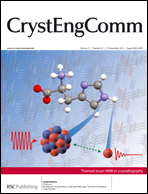A multinuclear solid state NMR, density functional theory and X-Ray diffraction study of hydrogen bonding in Group I hydrogen dibenzoates†
Abstract
An NMR crystallographic approach incorporating multinuclear solid state NMR (SSNMR), X-ray structure determinations and density functional theory (DFT) are used to characterise the H bonding arrangements in benzoic acid (BZA) and the corresponding Group I alkali metal hydrogen dibenzoates (HD) systems. Since the XRD data often cannot precisely confirm the proton position within the hydrogen bond, the relationship between the experimental SSNMR parameters and the ability of gauge included plane augmented wave (GIPAW) DFT to predict them becomes a powerful constraint that can assist with further structure refinement. Both the 1H and 13C MAS NMR methods provide primary descriptions of the H bonding via accurate measurements of the 1H and 13C isotropic chemical shifts, and the individual 13C chemical shift tensor elements; these are unequivocally corroborated by DFT calculations, which together accurately describe the trend of the H bonding strength as the size of the monovalent cation changes. In addition, 17O MAS and DOR NMR form a powerful combination to characterise the O environments, with the DOR technique providing highly resolved 17O NMR data which helps verify unequivocally the number of inequivalent O positions for the conventional 17O MAS NMR to process. Further multinuclear MAS and static NMR studies involving the quadrupolar 7Li, 39K, 87Rb and 133Cs nuclei, and the associated DFT calculations, provide trends and a corroboration of the H bond geometry which assist in the understanding of these arrangements. Even though the crystallographic H positions in each H bonding arrangement reported from the single crystal X-ray studies are prone to uncertainty, the good corroboration between the measured and DFT calculated chemical shift and quadrupole tensor parameters for the Group I alkali species suggest that these reported H positions are reliable.

- This article is part of the themed collection: NMR crystallography

 Please wait while we load your content...
Please wait while we load your content...